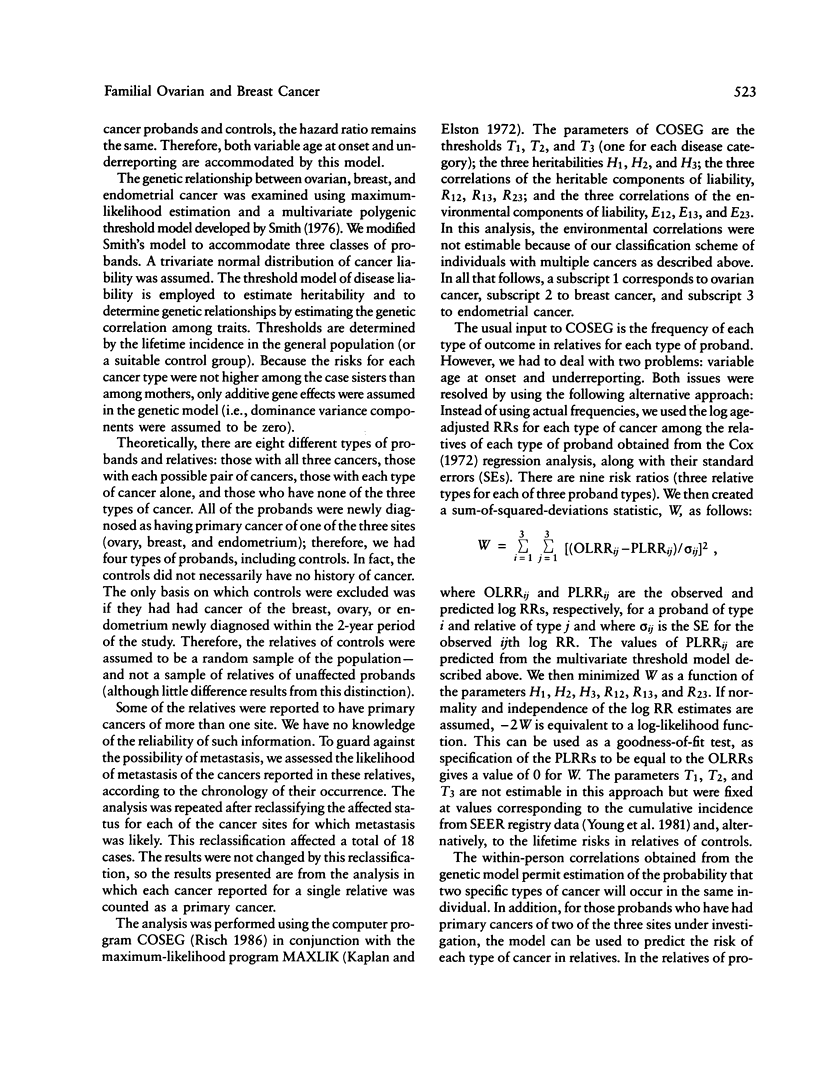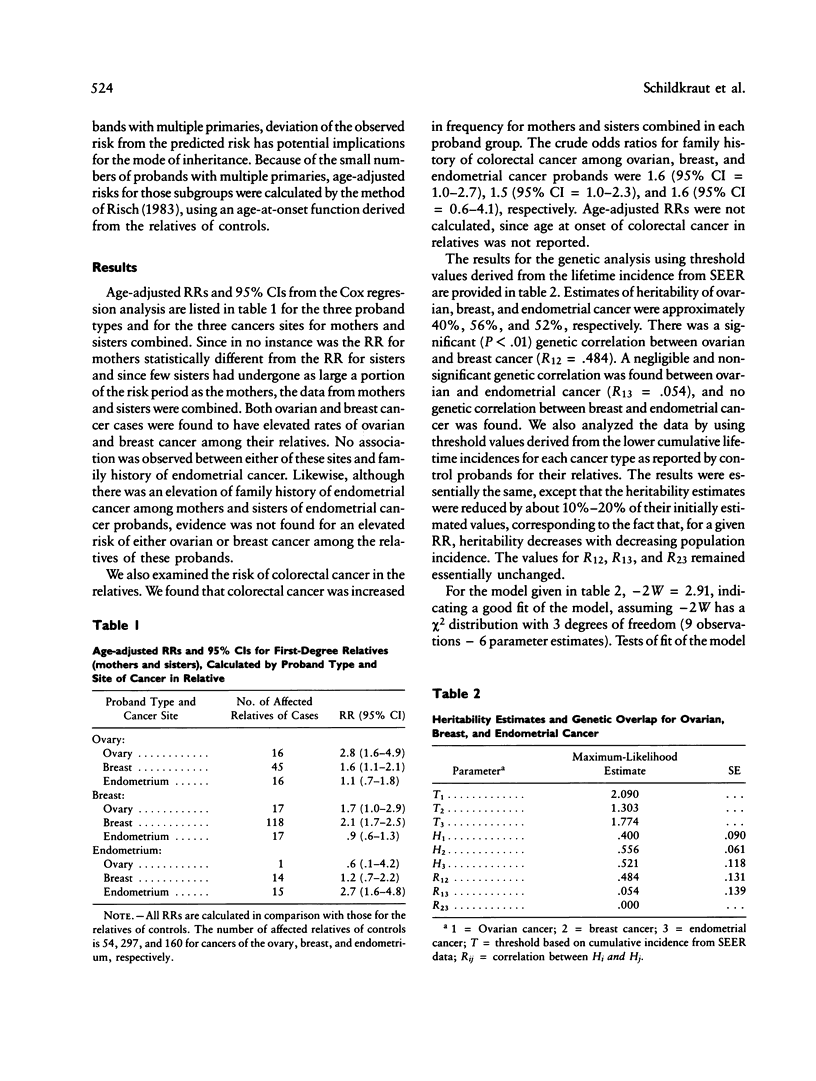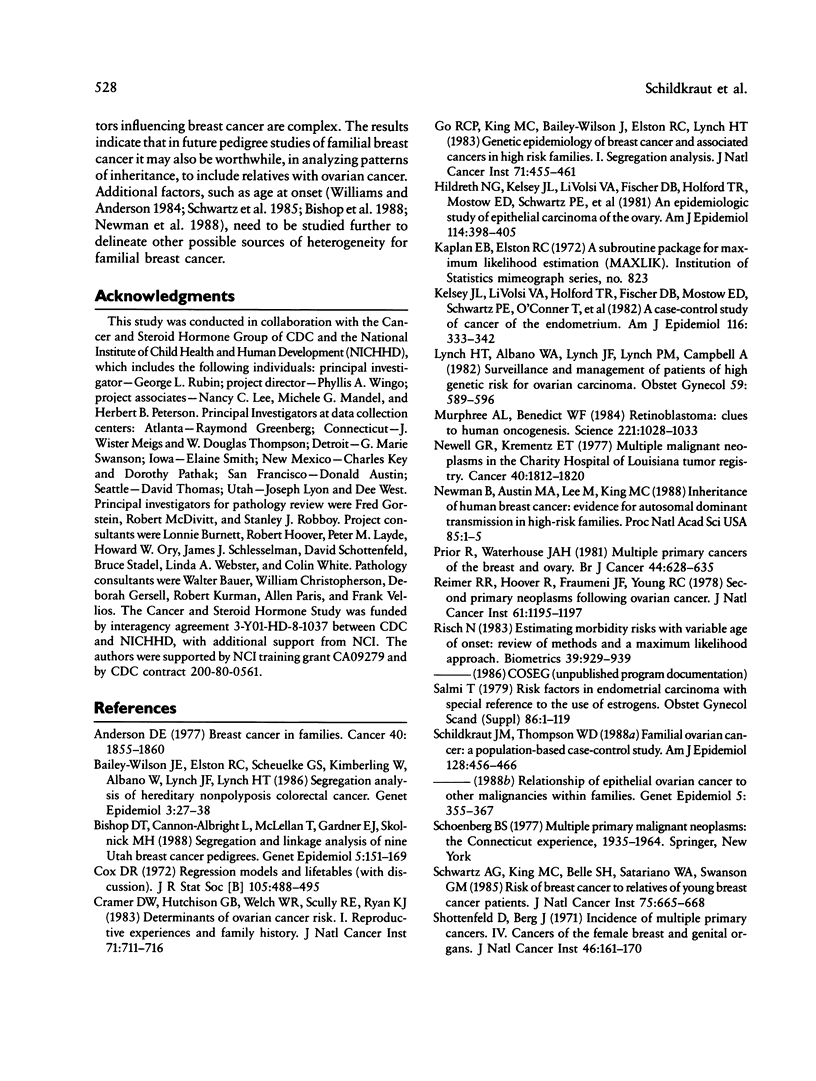Abstract
The possibility of a genetic relationship between ovarian, breast, and endometrial cancer was investigated in data from a large multicenter, population-based, case-control study, the Cancer and Steroid Hormone Study conducted by the Centers for Disease Control (CDC). Age-adjusted relative risks (RRs) for mothers and sisters of 493 ovarian cancer cases, 895 breast cancer cases, and 143 endometrial cancer cases versus 4,754 controls were calculated. Significantly elevated age-adjusted RRs were found for ovarian cancer (RR = 2.8; 95% confidence interval [CI] = 1.6-4.9) and breast cancer (RR = 1.6; 95% CI = 1.1-2.1) among relatives of ovarian cancer probands and for breast cancer (RR = 2.1; 95% CI = 1.7-2.5) and ovarian cancer (RR = 1.7; 95% CI = 1.0-2.0) among relatives of breast cancer probands. Relatives of endometrial cancer probands had an elevated RR for endometrial cancer only (RR = 2.7; 95% CI = 1.6-4.8). The genetic relationship between ovarian, breast, and endometrial cancer was tested using a multivariate polygenic threshold model developed by Smith (1976), which was modified to accommodate three classes of probands. Estimates of heritability for ovarian, breast, and endometrial cancer were 40%, 56%, and 52%, respectively. There was a significant genetic correlation between ovarian and breast cancer (R12 = .484). Evidence for significant genetic overlap between endometrial cancer and either ovarian or breast cancer was not found. These results suggest the existence of a familial breast/ovarian cancer syndrome. Endometrial cancer, while heritable, appears to be genetically unrelated.
Full text
PDF








Selected References
These references are in PubMed. This may not be the complete list of references from this article.
- Anderson D. E. Breast cancer in families. Cancer. 1977 Oct;40(4 Suppl):1855–1860. doi: 10.1002/1097-0142(197710)40:4+<1855::aid-cncr2820400814>3.0.co;2-1. [DOI] [PubMed] [Google Scholar]
- Bailey-Wilson J. E., Elston R. C., Schuelke G. S., Kimberling W., Albano W., Lynch J. F., Lynch H. T. Segregation analysis of hereditary nonpolyposis colorectal cancer. Genet Epidemiol. 1986;3(1):27–38. doi: 10.1002/gepi.1370030104. [DOI] [PubMed] [Google Scholar]
- Bishop D. T., Cannon-Albright L., McLellan T., Gardner E. J., Skolnick M. H. Segregation and linkage analysis of nine Utah breast cancer pedigrees. Genet Epidemiol. 1988;5(3):151–169. doi: 10.1002/gepi.1370050303. [DOI] [PubMed] [Google Scholar]
- Cramer D. W., Hutchison G. B., Welch W. R., Scully R. E., Ryan K. J. Determinants of ovarian cancer risk. I. Reproductive experiences and family history. J Natl Cancer Inst. 1983 Oct;71(4):711–716. [PubMed] [Google Scholar]
- Go R. C., King M. C., Bailey-Wilson J., Elston R. C., Lynch H. T. Genetic epidemiology of breast cancer and associated cancers in high-risk families. I. Segregation analysis. J Natl Cancer Inst. 1983 Sep;71(3):455–461. [PubMed] [Google Scholar]
- Hildreth N. G., Kelsey J. L., LiVolsi V. A., Fischer D. B., Holford T. R., Mostow E. D., Schwartz P. E., White C. An epidemiologic study of epithelial carcinoma of the ovary. Am J Epidemiol. 1981 Sep;114(3):398–405. doi: 10.1093/oxfordjournals.aje.a113207. [DOI] [PubMed] [Google Scholar]
- Kelsey J. L., LiVolsi V. A., Holford T. R., Fischer D. B., Mostow E. D., Schwartz P. E., O'Connor T., White C. A case-control study of cancer of the endometrium. Am J Epidemiol. 1982 Aug;116(2):333–342. doi: 10.1093/oxfordjournals.aje.a113417. [DOI] [PubMed] [Google Scholar]
- Lynch H. T., Albano W. A., Lynch J. F., Lynch P. M., Campbell A. Surveillance and management of patients at high genetic risk for ovarian carcinoma. Obstet Gynecol. 1982 May;59(5):589–596. [PubMed] [Google Scholar]
- Murphree A. L., Benedict W. F. Retinoblastoma: clues to human oncogenesis. Science. 1984 Mar 9;223(4640):1028–1033. doi: 10.1126/science.6320372. [DOI] [PubMed] [Google Scholar]
- Newell G. R., Krementz E. T. Multiple malignant neoplasms in the Charity Hospital of Louisiana Tumor Registry. Cancer. 1977 Oct;40(4 Suppl):1812–1820. doi: 10.1002/1097-0142(197710)40:4+<1812::aid-cncr2820400807>3.0.co;2-6. [DOI] [PubMed] [Google Scholar]
- Prior P., Waterhouse J. A. Multiple primary cancers of the breast and ovary. Br J Cancer. 1981 Nov;44(5):628–636. doi: 10.1038/bjc.1981.247. [DOI] [PMC free article] [PubMed] [Google Scholar]
- Reimer R. R., Hoover R., Fraumeni J. F., Jr, Young R. C. Second primary neoplasms following ovarian cancer. J Natl Cancer Inst. 1978 Nov;61(5):1195–1197. doi: 10.1093/jnci/61.5.1195. [DOI] [PubMed] [Google Scholar]
- Risch N. Estimating morbidity risks with variable age of onset: review of methods and a maximum likelihood approach. Biometrics. 1983 Dec;39(4):929–939. [PubMed] [Google Scholar]
- Salmi T. Risk factors in endometrial carcinoma with special reference to the use of estrogens. Acta Obstet Gynecol Scand Suppl. 1979;86:1–119. [PubMed] [Google Scholar]
- Schildkraut J. M., Thompson W. D. Familial ovarian cancer: a population-based case-control study. Am J Epidemiol. 1988 Sep;128(3):456–466. doi: 10.1093/oxfordjournals.aje.a114994. [DOI] [PubMed] [Google Scholar]
- Schottenfeld D., Berg J. Incidence of miltiple primary cancers. IV. Cancers of the female breast and genital organs. J Natl Cancer Inst. 1971 Jan;46(1):161–170. [PubMed] [Google Scholar]
- Schwartz A. G., King M. C., Belle S. H., Satariano W. A., Swanson G. M. Risk of breast cancer to relatives of young breast cancer patients. J Natl Cancer Inst. 1985 Oct;75(4):665–668. [PubMed] [Google Scholar]
- Sheshberadaran H., Payne L. G. Protein antigen-monoclonal antibody contact sites investigated by limited proteolysis of monoclonal antibody-bound antigen: protein "footprinting". Proc Natl Acad Sci U S A. 1988 Jan;85(1):1–5. doi: 10.1073/pnas.85.1.1. [DOI] [PMC free article] [PubMed] [Google Scholar]
- Smith C. Statistical resolution of genetic heterogeneity in familial disease. Ann Hum Genet. 1976 Jan;39(3):281–291. doi: 10.1111/j.1469-1809.1976.tb00132.x. [DOI] [PubMed] [Google Scholar]
- Strong L. C. Genetic and environmental interactions. Cancer. 1977 Oct;40(4 Suppl):1861–1866. doi: 10.1002/1097-0142(197710)40:4+<1861::aid-cncr2820400815>3.0.co;2-9. [DOI] [PubMed] [Google Scholar]
- Williams W. R., Anderson D. E. Genetic epidemiology of breast cancer: segregation analysis of 200 Danish pedigrees. Genet Epidemiol. 1984;1(1):7–20. doi: 10.1002/gepi.1370010104. [DOI] [PubMed] [Google Scholar]
- Wingo P. A., Ory H. W., Layde P. M., Lee N. C. The evaluation of the data collection process for a multicenter, population-based, case-control design. Am J Epidemiol. 1988 Jul;128(1):206–217. doi: 10.1093/oxfordjournals.aje.a114942. [DOI] [PubMed] [Google Scholar]


